All issues

Volume 40 (2000)
- Issue 4 Pages 237-
- Issue 3 Pages 187-
- Issue 2Supplement Pag・・・
- Issue 2 Pages 109-
- Issue 1 Pages 1-
Volume 40, Issue 3
Displaying 1-5 of 5 articles from this issue
- |<
- <
- 1
- >
- >|
-
Yasuhiko MORITA, Eiichi HONDA, Noiro YOSHINO, Tuguhisa KATOU, Kazunori ...2000 Volume 40 Issue 3 Pages 187-199
Published: September 30, 2000
Released on J-STAGE: September 05, 2011
JOURNAL FREE ACCESSPurpose: To optimize patient radiation dose in Spiral CT scan of dento-maxillo-facial region by measuring the absorbed dose in the phantom and to evaluate reliability of dose estimation methods using CTDI (CT Dose Index, FDA, USA).
Method: Spiral CT scanning with “pitchs” (ratio of table speed to slice thickness per rotation) more than 1 was used for dose measurements. The dose was measured using a human phantom (Alderson Research Laboratories, USA) in the CT scan with a 3rd generation CT scanner of Somatom Plus (Siemens, Germany) for bone imaging. CTDI for this CT scanner were 9.2mGy/ 100mA at the center in an acrylcic resin phantom with diameter of 16cm and 8.5mGy/100mA at 1cm depth from the phantom surface. X-ray tube voltage of 120kV and tube current of 85mA was used. Slice thickness was varied from 1 to 3mm and table speed per rotation was also varied from 1 to 5mm per rotation. X-Omat-V (Eastman Kodak, USA) films and TLD (Thermo-Luminescent-Dosimetry) dosimeters of the type of MSO-S (Kyokko, Japan) were used in the dosimetry.
Result: Patient radiation dose reduced with increasing the pitch of SPIRAL scan. Measured dose was uniformly distributed and well corresponded to the dose calculated using CTDI. However, measured doses on scanning with 1mm slice thickness were always higher than those with 2 to 5mm slice thickness. The lowest radiation dose was obtained with scanning with 2mm slice thickness and table speed of 4mm per rotation which give the dose of about 4mGy per one CT examination in the imaged tissues. The highest dose per one CT examination was measured in “dental CT” for the mandibular region with 1mm slice thickness and table speed of 1mm per rotation which gave 12mGy by film dosimetry and 9 mGy by TLD dosimetry.
Conclusion: SPIRAL scan with pitch more than 1 was effective for reduction of patient radiation dose without reducing the image quality. CTDI was also useful to estimate the dose except scans with 1mm slice thickness.View full abstractDownload PDF (1909K) -
Akira TAKAHASHI, Manabu SHIMOMURA, Chieko SUGAWARA-TAKAHASHI, Shusabur ...2000 Volume 40 Issue 3 Pages 200-208
Published: September 30, 2000
Released on J-STAGE: September 05, 2011
JOURNAL FREE ACCESSPseudoaneurysms of the lingual artery are extremely rare. They can be difficult to diagnose and potentially life-threatening. In this report, a case of unusual lingual artery pseudoaneurysm is presented from the standpoint of image diagnosis. A 55-year-old female presented with gradually increasing swelling and pain in the submandibular area. Plain radiograms showed a calcified body surrounding a mass and mandibular erosion. Ultrasonography (US) showed a hypoechoic mass containing pulsatile vessels. Computed tomography (CT) showed a smooth round mass with a combination of an enhancing component and a region of lower attenuation. The latter component was composed of a mixture of high- and low signal intensities in Magnetic Resonance Imaging (MRI), suggesting the presence of coagulation. Angiography revealed limited dilation of the proximal lingual artery. Magnetic resonance angiography (MRA) showed dislocation of carotid arteries but the originating artery was not specified because the dilation of the proximal lingual artery, as revealed by conventional angiography, was limited. Sialography of the submandibular gland showed irreversible degenerative change in the gland due to the aneurysm. The utility of these modalities is discussed.View full abstractDownload PDF (11604K) -
Masao ARAKI, Koji HASHIMOTO, Koji SHINODA, Kazuo KOMIYAMA2000 Volume 40 Issue 3 Pages 210-211
Published: September 30, 2000
Released on J-STAGE: September 05, 2011
JOURNAL FREE ACCESSDownload PDF (2723K) -
Masao ARAKI, Kenichiro EJIMA, Kunihiko SAWADA, Koji HASHIMOTO, Koji SH ...2000 Volume 40 Issue 3 Pages 212-213
Published: September 30, 2000
Released on J-STAGE: September 05, 2011
JOURNAL FREE ACCESSDownload PDF (2262K) -
2000 Volume 40 Issue 3 Pages 214-221
Published: September 30, 2000
Released on J-STAGE: September 05, 2011
JOURNAL FREE ACCESSDownload PDF (1273K)
- |<
- <
- 1
- >
- >|